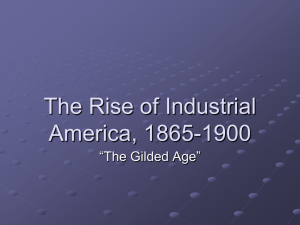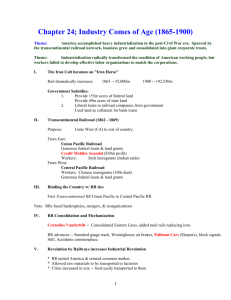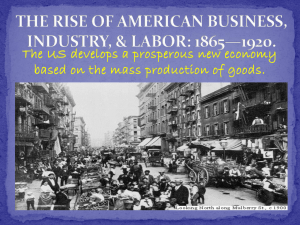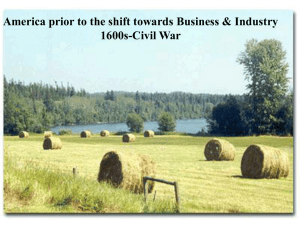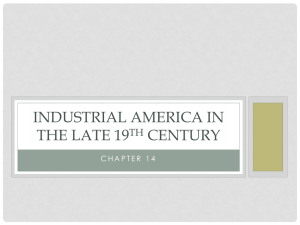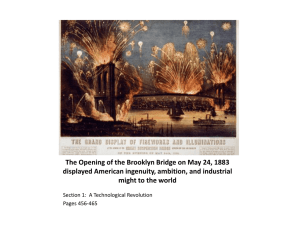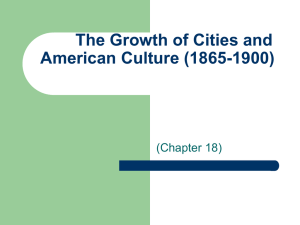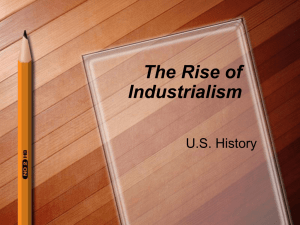The Rise of Industrial America, 1865
advertisement
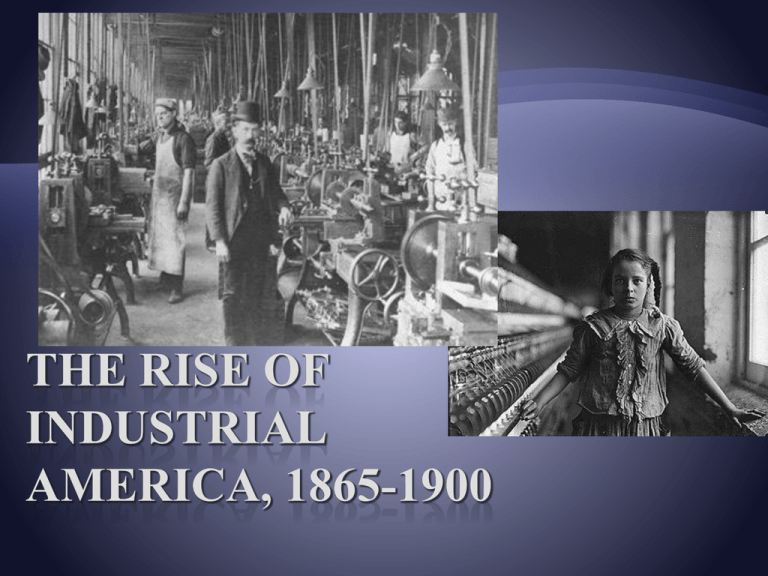
The Rise of Big Business 1900 – U.S. is leading industrial power Exceeds Great Britain, France, and Germany 4% growth per year Reasons: Natural resources Massive labor supply Growing population Capital - $$$$ Labor-saving technologies Friendly govt. policies Talented entrepreneurs The Business of Railroads BIGGEST business 1865 – 35,000 miles of track 1900 – 190,000 miles 1883 – split U.S. into four time zones Created market for commercial goods Eastern Trunk Lines: 1830-1860 – Huge growth Different gauge tracks After Civil War – RRs consolidated Cornelius Vanderbilt – 1867 – New York Central 4,500 miles of track NYC to Chicago Western Railroads: Played a role in settling West Promoted settlements on Great Plains Linking East to West creating one market Federal land grants 80 rail companies Problems: Hasty and poor construction Led to widespread corruption Transcontinental RR Pre-Civil War land grants Link CA to Union Union Pacific – started at Omaha, NE Central Pacific – Sacramento to ??? Constructed by Chinese and Irish Met at Promontory Point, UT – May 10, 1869 Panic of 1893 ¼ of all RRs went bankrupt J. Pierpont Morgan Consolidated RRs Eliminated competition Controlled 7 companies by 1900 Industrial Empire Major shift in output Antebellum Textiles Clothing Lumber Leather products Postbellum Heavy industry Steel Petroleum Electrical power Steel Industry 1850s – Henry Bessemer and William Kelly Bessemer Process Great Lakes region becomes hotbed for steel Minnesota’s Mesabi Range Andrew Carnegie 1848 – Scottish immigrant Superintendant of RRs 1870s – Pittsburgh, PA Technology Salesmanship Horizontal and Vertical Integration Carnegie Steel Corp. 20,000 employees Produced more steel than ALL of Great Britain U.S. Steel Carnegie retires Sold company in 1900 for $400 million to J.P. Morgan Control 3/5 of all steel 168,000 employees Petroleum Industry 1859 – Edwin Drake – Titusville, PA 1863 – John D. Rockefeller – Standard Oil Company By 1891 – controlled 90% of oil industry Established “trusts” – conglomerates of businesses $900 million fortune Laissez-Faire Capitalism Adam Smith (1776) Wealth of Nations Social Darwinism “Survival of the Fittest” Gospel of Wealth Carnegie Anti-Trust Movement Trusts came under harsh scrutiny Middle class believed trusts controlled everything Sherman Anti-Trust Act (1890) Prohibited creation of trusts Tried to make trade honest Marketing Consumer Goods Increased demand for goods Increased output Decreased price R.H. Macy Frank Woolworth Sears Roebuck and Montgomery Ward Inventions and Inventors Between 1860 – 19,591 patents By 1900 – over 400,000 patents Changed the way we did everything!!! American Workforce Workers were poor Top 10% of wealthiest owned 90% of income “New Money” Working conditions were horrible Living conditions were unsanitary Horatio Alger Myth “Rags to Respectability” Organized Labor National Labor Union 1860s First union to try to unionize all workers Higher wages 8-hour day Equal rights Lost members during Panic of 1873 Knights of Labor 1869 – secret society Wanted members from ALL work forces Demands: Worker cooperatives Abolish child labor Abolish trusts and monopolies Settled disputes legally Haymarket Bombing – May 4, 1886 American Federation of Labor Samuel Gompers – 1886 Economic-minded Method: Collective bargaining 1901 – 1 million members Immigration 1850 – 23.2 million 1900 – 76.2 million 1850-1900 – 16.2 million immigrants entered U.S. Pushes Poverty Overcrowding Religious persecution Pulls: Tolerance Jobs!!! “Streets were paved with gold” Old vs. New Old immigrants: England Germany Scandinavia New immigrants: Russia Italy Greece Croatia Poland Incoming Terminals Ellis Island, New York Europeans Angel Island, California Asians Urbanization By 1900 – 40% of Americans lived in cities Tenements Lousy conditions Ethnic neighborhoods Safe havens Political Machines Tammany Hall – NYC Boss Tweed 1860s – 1871 Backed and protected immigrants New York County Courthouse (1870) Thomas Nast Harper’s Weekly Mugwumps – wanted to end reform Awakening of Reform: Problems in cities were brought to attention Books of social criticism How the Other Half Lives A History of Standard Oil Company The Jungle Settlement House Movement Educated reformers Moved into ghettos Hull House – Chicago Jane Addams (1889) Taught immigrants English Childhood education Industrial arts education By 1900 – 400 settlement houses Women’s Movements Women’s Christian Temperance Movement (1874) Frances Willard Anti-Saloon League (1893) Cary Nation
